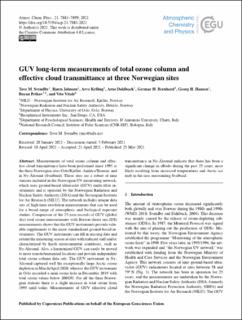| dc.contributor.author | Svendby, Tove Marit | |
| dc.contributor.author | Johnsen, Bjørn | |
| dc.contributor.author | Kylling, Arve | |
| dc.contributor.author | Dahlback, Arne | |
| dc.contributor.author | Bernhard, Germar H. | |
| dc.contributor.author | Hansen, Georg Heinrich | |
| dc.contributor.author | Petkov, Boyan | |
| dc.contributor.author | Vitale, Vito | |
| dc.date.accessioned | 2021-06-01T08:21:48Z | |
| dc.date.available | 2021-06-01T08:21:48Z | |
| dc.date.created | 2021-05-31T10:57:43Z | |
| dc.date.issued | 2021 | |
| dc.identifier.citation | Atmospheric Chemistry and Physics. 2021, 21, 7881-7899. | en_US |
| dc.identifier.issn | 1680-7316 | |
| dc.identifier.uri | https://hdl.handle.net/11250/2757153 | |
| dc.description.abstract | Measurements of total ozone column and effective cloud transmittance have been performed since 1995 at the three Norwegian sites Oslo/Kjeller, Andøya/Tromsø, and in Ny-Ålesund (Svalbard). These sites are a subset of nine stations included in the Norwegian UV monitoring network, which uses ground-based ultraviolet (GUV) multi-filter instruments and is operated by the Norwegian Radiation and Nuclear Safety Authority (DSA) and the Norwegian Institute for Air Research (NILU). The network includes unique data sets of high-time-resolution measurements that can be used for a broad range of atmospheric and biological exposure studies. Comparison of the 25-year records of GUV (global sky) total ozone measurements with Brewer direct sun (DS) measurements shows that the GUV instruments provide valuable supplements to the more standardized ground-based instruments. The GUV instruments can fill in missing data and extend the measuring season at sites with reduced staff and/or characterized by harsh environmental conditions, such as Ny-Ålesund. Also, a harmonized GUV can easily be moved to more remote/unmanned locations and provide independent total ozone column data sets. The GUV instrument in Ny-Ålesund captured well the exceptionally large Arctic ozone depletion in March/April 2020, whereas the GUV instrument in Oslo recorded a mini ozone hole in December 2019 with total ozone values below 200 DU. For all the three Norwegian stations there is a slight increase in total ozone from 1995 until today. Measurements of GUV effective cloud transmittance in Ny-Ålesund indicate that there has been a significant change in albedo during the past 25 years, most likely resulting from increased temperatures and Arctic ice melt in the area surrounding Svalbard. | en_US |
| dc.language.iso | eng | en_US |
| dc.rights | Navngivelse 4.0 Internasjonal | * |
| dc.rights.uri | http://creativecommons.org/licenses/by/4.0/deed.no | * |
| dc.title | GUV long-term measurements of total ozone column and effective cloud transmittance at three Norwegian sites | en_US |
| dc.type | Peer reviewed | en_US |
| dc.type | Journal article | en_US |
| dc.description.version | publishedVersion | en_US |
| dc.rights.holder | © Author(s) 2021. | en_US |
| dc.source.pagenumber | 7881-7899 | en_US |
| dc.source.volume | 21 | en_US |
| dc.source.journal | Atmospheric Chemistry and Physics | en_US |
| dc.identifier.doi | 10.5194/acp-21-7881-2021 | |
| dc.identifier.cristin | 1912777 | |
| dc.relation.project | NILU: 121002 | |
| cristin.ispublished | true | |
| cristin.fulltext | original | |
| cristin.qualitycode | 2 | |

